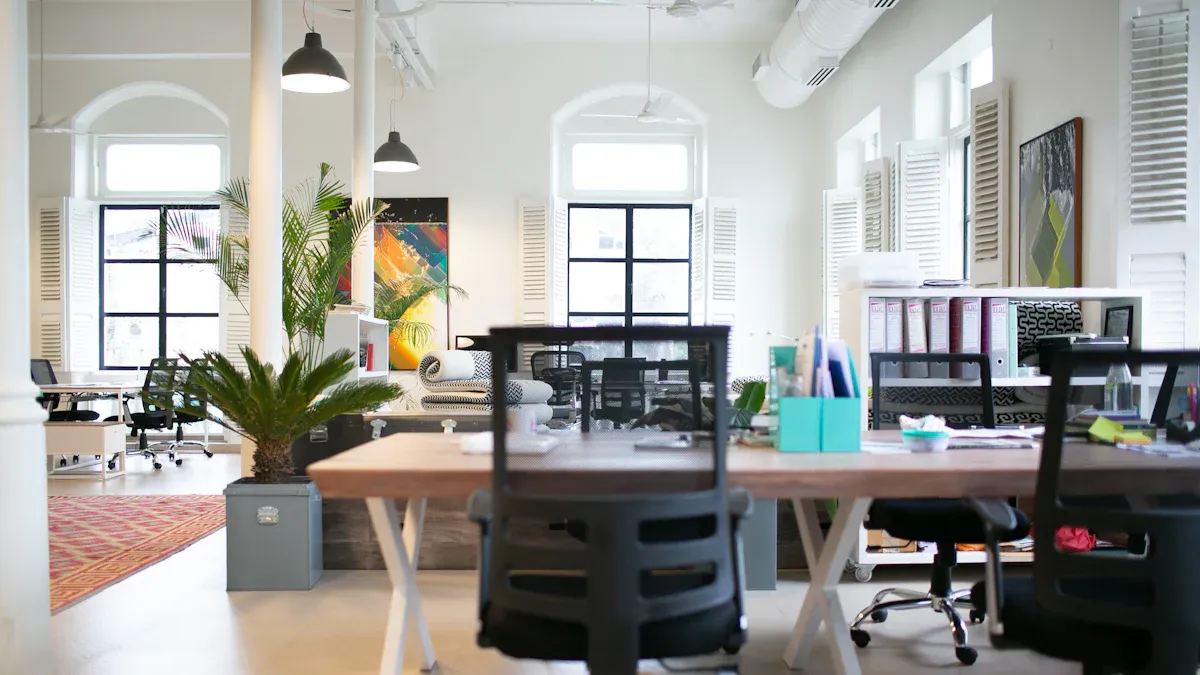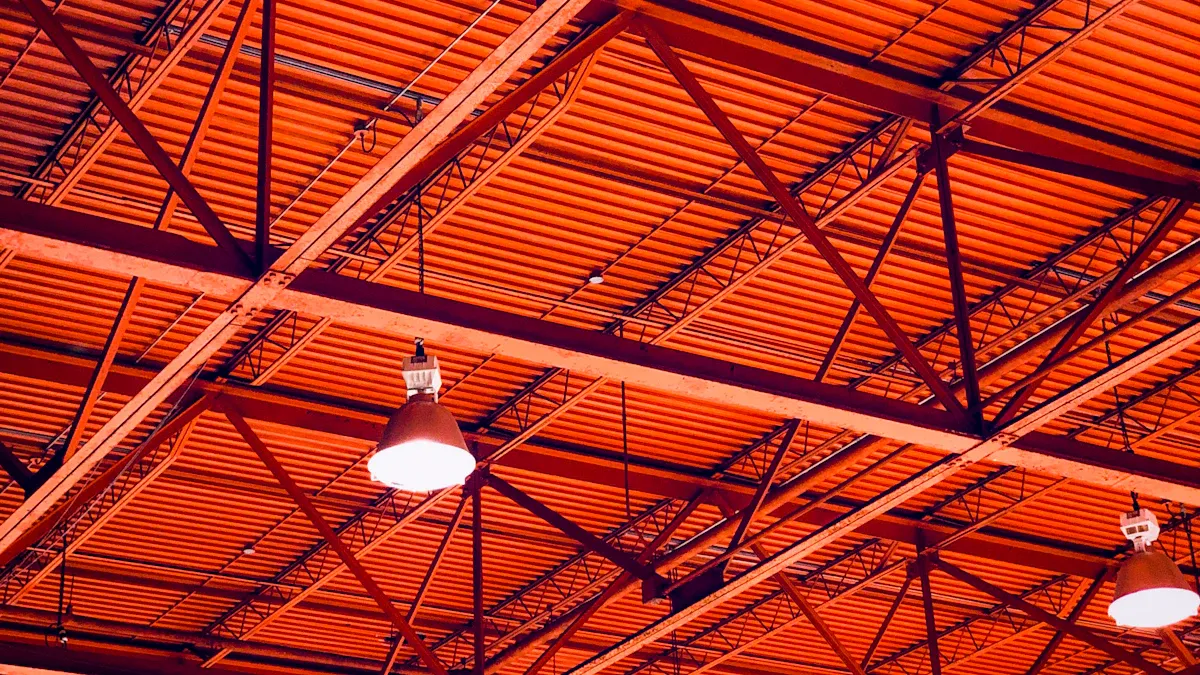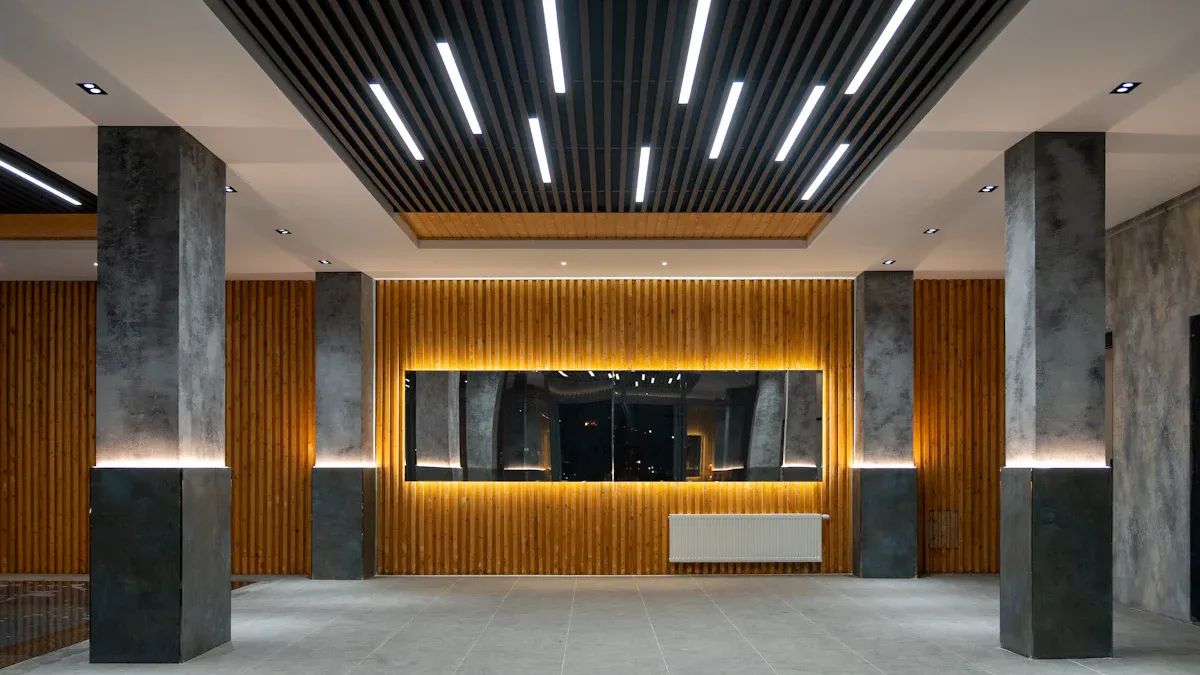Commercial LED Lighting: How to Select Fixtures for Specific Industry Requirements

Selecting commercial LED lighting starts with understanding your unique business requirements and the standards that shape your industry. You need to focus on energy efficiency, lighting quality, and compliance to improve productivity, safety, and brand image. Industry benchmarks show that commercial lighting must deliver cost savings, consistent performance, and durability.
Energy-efficient LED fixtures lower operational costs and support sustainability.
Smart controls, such as motion sensors, reduce energy waste and increase efficiency.
Durable commercial lighting stands up to demanding environments, reducing maintenance.
You can enhance both function and aesthetics by choosing the right Led Light for your space. For more details, visit our Home, About Us, or Product pages.
Key Takeaways
Assess each space’s purpose and lighting needs carefully to choose fixtures that improve comfort, safety, and productivity.
Select energy-efficient LED lighting with the right brightness and color temperature to save costs and support sustainability.
Follow industry standards and safety codes to ensure compliance and protect your business and occupants.
Use smart lighting controls like motion sensors and dimmers to reduce energy waste and create flexible lighting environments.
Plan regular maintenance to extend fixture life, reduce downtime, and keep your lighting system efficient and reliable.
Assessing Space & Industry Needs

Area Purpose
You need to start by defining the purpose of each area in your commercial property. Every space has unique lighting requirements based on its function. For example, a retail store needs brighter lighting to highlight products, while a warehouse requires even illumination for safety and efficiency. Use these steps to guide your assessment:
Measure lighting needs using foot-candles. Hallways often need 20-25 foot-candles, retail shops about 50, and warehouses between 10-30.
Keep light temperature consistent to create a comfortable environment.
Choose lighting fixtures with a high Color Rendering Index (CRI 80-100) for accurate color display.
Select LED fixtures for energy efficiency and long-term savings.
Adjust color, tone, and brightness to match the business function and desired atmosphere.
Combine ambient, task, and accent lighting to improve both function and appearance.
Place task lighting where focused activities happen, using energy-efficient sources.
Reduce glare and manage reflections by considering surface finishes.
Align lighting design with your business goals to boost productivity and safety.
Tip: Avoid one-size-fits-all solutions. Tailor lighting to each area’s function, size, and layout for the best results.
Industry Standards
You must follow industry standards to ensure safety and compliance in your commercial lighting plan. These standards help you select the right fixtures and avoid costly mistakes.
Standard/Guideline | Description |
|---|---|
Ensure safety and productivity in commercial and industrial environments. | |
IP Rating | Measures protection against dust and water, key for durable fixtures. |
IK Rating | Indicates impact resistance for lighting fixtures. |
NFPA | Sets fire safety and emergency lighting requirements. |
IEC Standards | Define international safety and performance for lighting. |
Maintenance & Emergency | Regular checks keep emergency lighting compliant and reliable. |
Following these guidelines helps you create a safe, efficient, and compliant commercial property lighting system.
Occupant Activities
You should consider how people use each space. Occupant activities shape the effectiveness of your lighting fixtures. Glare can cause discomfort and lower productivity. Flicker from poor-quality lighting leads to eyestrain and headaches. When you give occupants control over their lighting, satisfaction and motivation rise. Preferences change based on mood, activity, and health, so flexible lighting solutions work best.
Flicker causes eyestrain and lowers well-being.
Allowing control over lighting boosts satisfaction and productivity.
Occupant behavior affects energy use and lighting efficiency.
Daylight integration improves mood and reduces electric lighting needs.
A commercial lighting plan that adapts to occupant needs creates a healthier, more productive environment.
Evaluating Current Lighting
Lighting Performance
You should start by measuring how well your current lighting system works. Use key performance indicators to get a clear picture of your lighting quality and effectiveness.
Illuminance (lux) tells you how much light reaches a surface.
Luminance (cd/m²) measures the brightness you see from a fixture or surface.
Brightness level and contrast ratios affect how easily you can see details.
Uniformity ensures light spreads evenly across your space.
Glare indices help you spot areas that may cause discomfort or reduce productivity.
Correlated Color Temperature (CCT) and Color Rendering Index (CRI) show how well your lighting fixtures display colors and create the right mood.
Color preference and saturation influence how people feel in your space.
Non-visual factors, like circadian stimulus, impact health and alertness.
You can use tools such as spectroradiometers or RGB sensors to measure these values. These metrics help you decide if your lighting supports both visual tasks and well-being.
Gaps & Improvements
When you review your current fixtures, you often find gaps that limit performance. Many commercial spaces still use outdated lighting technologies, such as fluorescent or metal halide fixtures. These consume more energy and need frequent maintenance. Poor layouts and over-illumination waste energy and money.
Lack of modern controls, like motion sensors or dimmers, is common.
Inefficient fixture placement can create dark spots or glare.
Inappropriate wattage leads to higher costs and lower efficiency.
Lighting audits often recommend upgrades to LED lighting fixtures, smart controls, and better layouts. These changes can boost energy efficiency, improve safety, and support your sustainability goals.
Lighting Goals
Set clear goals for your lighting upgrade. Many industries aim for ambient lighting levels around 10 foot-candles, with task lighting reaching 50 foot-candles for detailed work. Choose energy-efficient lighting fixtures, such as LEDs, to cut power use and lower costs.
Use daylight where possible to reduce reliance on artificial lighting.
Select color temperatures that reduce glare and eyestrain, such as below 3200K for warm light or around 4000K for cool light.
Add smart controls, like automated dimming and motion sensors, to optimize lighting use.
Layer ambient and task lighting to create comfortable, productive spaces.
These steps help you achieve measurable savings, improve comfort, and support productivity.
Technical Factors for Lighting Fixtures
Lumens & Brightness
You need to understand how to calculate the right brightness for your commercial space. The key measurement is lumens, which tells you how much visible light a fixture produces. To determine the total lumens required, multiply the square footage of your area by the recommended foot-candle level for your industry. Foot-candles measure the amount of light needed per square foot. This method ensures your commercial lighting supports every activity and meets safety standards.
Commercial Space Type | Recommended Foot-Candle Range | Example Calculation (Square Footage × Foot-Candle) | Lumens Needed Example |
|---|---|---|---|
Offices | 30–50 | 200 sq. ft. × 40 fc | 8,000 lumens |
Warehouses | 10–30 | 1,000 sq. ft. × 20 fc | 20,000 lumens |
Retail Spaces | 50–80 | 500 sq. ft. × 60 fc | 30,000 lumens |
General Commercial | 20–30 | N/A | N/A |
You should also adjust for ceiling height and wall color. High ceilings and dark surfaces absorb more light, so you may need to increase the lumens. For example, a space with very dark walls could require up to four times more lumens than a room with light-colored walls.
Real-world projects show how these calculations improve commercial LED lighting. In an office renovation, engineers increased productivity by selecting LED fixtures with higher lumens and repositioning them for better brightness. Retail stores often use a mix of ambient and accent lighting to highlight products and create a welcoming atmosphere. Healthcare facilities use cooler color temperatures in staff areas and warmer tones in patient rooms, balancing comfort and efficiency.
Tip: Always match the lumens and brightness to the specific tasks and activities in each area. This approach ensures your lighting fixtures deliver both comfort and performance.
Energy Efficiency
You want your commercial LED lighting to deliver strong energy efficiency and long-term savings. Federal standards require manufacturers to design lighting products that use less energy. The ENERGY STAR program certifies products that exceed these standards. ENERGY STAR-certified LED bulbs use about 75% less energy and last up to 25 times longer than incandescent bulbs. These products also produce less heat, which lowers cooling costs and improves overall efficiency.
LED lighting emits light in a specific direction, reducing wasted energy.
LEDs generate very little heat, unlike incandescent or CFL bulbs.
Most LED products last 3 to 5 times longer than CFLs and up to 30 times longer than incandescent bulbs.
ENERGY STAR-rated fixtures include accent lights, recessed downlights, and task lighting.
You should look for ENERGY STAR certification when selecting commercial lighting fixtures. This label signals high energy efficiency and reliable performance. In commercial applications, LEDs can reduce power consumption by up to 80% compared to traditional bulbs. Their long lifespan—up to 50,000 hours—means fewer replacements and lower maintenance costs. Automation technologies, such as motion sensors and timers, further boost energy efficiency by reducing wasted light.
Studies show that upgrading to LED lighting in commercial spaces can cut energy use by up to 90%. Improved thermal management in LED fixtures extends their lifespan, making them a cost-effective choice for your business. You support sustainability goals and reduce operational costs by choosing efficient lighting.
Compliance & Safety
You must ensure your commercial lighting meets all compliance and safety standards. Codes like ASHRAE 90.1 and the International Energy Conservation Code (IECC) set strict requirements for lighting power density and controls. These standards require features such as occupancy sensors, daylight dimming, and automatic shutoff to reduce energy use. Compliance with these codes is essential for both new installations and major renovations.
Description | Key Requirements | |
|---|---|---|
ASHRAE/IES 90.1-2016 | National energy standard for commercial buildings | Lighting power density limits, mandatory controls, functional testing, documentation |
IECC 2018 | Model building energy code | Similar power and control requirements, applies to new and existing buildings |
Lighting Controls | Required by both standards | Occupancy sensors, daylight-responsive controls, automatic shutoff |
Exemptions | Some minor retrofits may be exempt | Applies if replacing less than 10% of luminaires without increasing power |
You should also follow OSHA requirements for minimum illumination and the Americans with Disabilities Act (ADA) for accessibility and glare reduction. The Illuminating Engineering Society (IES) provides best practices for recommended light levels.
Adhering to safety standards, such as those from IEC and UL, prevents hazards like overheating and toxic emissions. Compliance builds trust with customers and protects your business from legal and financial risks. For example, meeting OSHA and NFPA emergency lighting standards ensures safe evacuation routes and maintains insurance coverage. Non-compliance can lead to fines, legal issues, and even business shutdowns.
Note: Compliance with industry standards not only protects your business but also boosts employee and customer confidence in your commercial lighting solutions.
Commercial Lighting Applications

Retail & Hospitality
You shape customer experience and brand identity with your lighting choices in retail and hospitality spaces. Fixtures in these environments do more than provide light—they create atmosphere and guide shoppers. In retail, you often use built-in shelving with integrated LED lighting, floating shelves, and configurable wall systems. These fixtures highlight products and help customers navigate the store. Hospitality settings, such as hotels and restaurants, focus on comfort and luxury. You might select custom cabinetry, under-counter lighting, and wall sconces made from high-quality materials like wood, glass, or metal.
Lighting design in these sectors uses a mix of ambient, accent, and dynamic lighting. Luxury retail stores often combine low ambient light with bright accent lights to create an exclusive feel. In contrast, fast-moving consumer goods stores use neutral white light and minimalist fixtures to reflect a modern brand. Hospitality spaces benefit from tunable white systems and motion-activated lighting, which create flexible and comfortable environments. Smart controls and interactive lighting effects can further enhance engagement and reinforce your brand.
Tip: Use lighting to evoke emotion and make your commercial property lighting memorable for every guest or shopper.
Office & Education
You improve productivity and learning by choosing the right lighting for offices and schools. Studies show that full-spectrum lighting and daylight increase focus and reduce stress. For example:
Classrooms with full-spectrum lighting and blue walls saw a 22% drop in off-task behavior.
Optimized lighting lowered blood pressure, showing less stress.
More daylight in schools led to higher math and reading scores.
Cool white lighting boosted reading speed and attention, while warm white lighting helped adults work together.
Flicker and glare can hurt comfort and performance, so you need to select fixtures that reduce these issues.
Lighting in offices and schools should support circadian rhythms. You can use dynamic LED systems that adjust color temperature and brightness throughout the day. This approach helps people stay alert and comfortable. Good lighting design combines natural daylight with artificial light, creating a healthy and productive environment.
Industrial & Warehouse
You face unique challenges in industrial and warehouse settings. These large spaces need powerful, efficient lighting to keep workers safe and productive. High bay LED lights work well for ceilings over 15 feet, providing strong, focused light. Low bay LEDs suit lower ceilings and offer softer, task-focused lighting. You can use LED strip lights for accent or task lighting in tight areas.
Smart LED lighting with sensors adjusts brightness based on occupancy and daylight, saving energy. Motion-activated lights turn on only when needed, improving safety and cutting costs. LED wall packs and flood lights secure building exteriors and loading docks. Panel LED lights and downlights work well in office areas within warehouses.
LED fixtures last longer and use less energy than traditional lighting. They also provide better color rendering, which helps workers see clearly and avoid mistakes. By choosing the right commercial lighting, you reduce maintenance, lower energy bills, and create a safer workplace.
Smart Controls & Design
Lighting Controls
You can transform your commercial lighting with smart controls. These systems use cloud networks and advanced sensors to monitor and adjust lighting in real time. Energy managers track usage and optimize settings through specialized software. Smart gateways connect different devices, using protocols like ZigBee, Wi-Fi, and Bluetooth.
Smart lighting controllers let you automate fixture operation based on occupancy, daylight, or schedules. For example, occupancy sensors and dimming controls can cut lighting energy use by up to 50%. A California office building reduced its energy consumption by 40% after installing a system with occupancy sensors, dimming, and time-based scheduling.
Modern smart LED fixtures include sensors that adjust brightness and color temperature. Real-time data helps you adapt lighting to occupant needs and daylight, improving comfort and saving energy. Human-centric lighting supports circadian rhythms, boosting productivity and well-being.
Tip: Start with a lighting audit, then select controls that match your business needs. Integrate with HVAC systems for even greater efficiency.
Branding & Aesthetics
Lighting shapes how people see your brand. Creative lighting design expresses your company’s identity and makes your space memorable. You can use custom LED fixtures with different colors and brightness to match your brand’s mood.
Layered lighting—combining ambient, task, and accent lights—improves both looks and function. Smart systems let you change lighting for events or promotions, keeping your brand fresh and engaging.
Consistent lighting across locations builds recognition and trust. Good lighting also highlights products and creates inviting spaces, improving customer experience and employee engagement.
Define your brand values and choose lighting styles that reflect them.
Work with designers to align lighting with your interior and brand goals.
Use dynamic controls to adjust lighting for different moods or events.
Maintenance Planning
You extend the life of your LED lighting with a solid maintenance plan. Choose fixtures with quality heat sinks and cooling systems to prevent overheating. Keep voltage stable with high-quality power supplies and surge protection.
Regular cleaning removes dust that blocks light and traps heat. Schedule inspections to catch loose connections or damaged wires early. Use compatible dimmers and avoid rapid on-off cycling to reduce stress on LEDs.
Follow manufacturer guidelines for installation and cleaning. Replace failing drivers promptly to keep your system running smoothly.
Note: Proactive maintenance saves money, reduces downtime, and keeps your lighting efficient for years.
You achieve the best results in commercial LED lighting by following a structured process. Start by evaluating your space, researching efficient products, and testing samples. Work with professionals to ensure compliance with NEC, NFPA, IESNA, and ADA standards. The table below shows how this approach improves both energy efficiency and safety:
Case Study | Approach Taken | Outcome |
|---|---|---|
Retail Shop | High CRI LEDs, tailored track lighting | Better visibility, lower energy costs |
Industrial Complex | Custom LED retrofit, advanced controls | Safer work zones, fast ROI, reduced costs |
Take the next step—plan your upgrade and consult experts for long-term value.
FAQ
What is the best way to determine how many LED fixtures you need?
You should measure your space in square feet. Multiply that number by the recommended foot-candle level for your industry. This calculation gives you the total lumens needed. Divide by the lumen output of your chosen fixture to find the quantity.
How do you choose the right color temperature for your business?
Select color temperature based on your space’s purpose. Use warm white (2700K–3000K) for hospitality. Choose neutral white (3500K–4100K) for offices. Pick cool white (5000K–6500K) for industrial or task-focused areas.
Do LED lights really lower maintenance costs?
Yes. LED fixtures last much longer than traditional bulbs. You replace them less often. This reduces labor and material costs. LEDs also resist vibration and temperature changes, which helps in demanding environments.
Are smart lighting controls worth the investment?
Smart controls help you save energy and improve comfort. You can automate lighting schedules, adjust brightness, and use occupancy sensors. These features cut energy waste and support sustainability goals.
See Also
Selecting The Best LED Lighting For Commercial Use
Must-Have Commercial Lighting Fixtures For Every Business
Effective Commercial Lighting Solutions And Practices For Businesses

